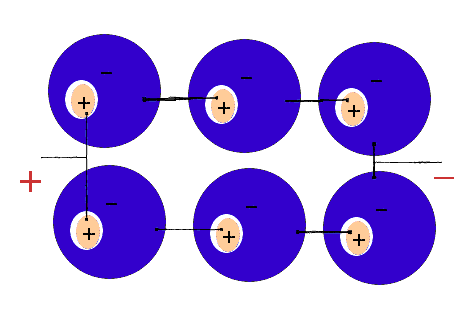Homemade Battery
The modern world runs on energy and electrical energy is one form that we have grown so accustomed to we would be lost without it. After society breaks down and your batteries go dead, knowing how to produce your own electricity will help bring back some of our tools that we rely on so heavily each and every day. Lighting being one of the most sought after jobs electricity does so well.
Batteries can power lights start engines and other stuff so knowing how to make your own can provide you with usable electricity long after The End.
Alright, so let's start simple. You can make a 1.5 volt battery by placing a copper bar and an aluminum bar in a cup of water. And then connect them above the water with a piece of wire. Pour a teaspoon of bleach into the water and you have your first battery. The wire is now transferring electricity at 1.5 volts from one bar to the other. Of course unless you have some sort of meter between the two you would never know it.
The more bleach the more amps you get and the faster the bars will corrode.
Tip: a teaspoon of bleach to one gallon of water will allow this simple small battery to last for about three months.
The aluminum and copper will last a long time. Every three months you will need to empty the water and lightly sand the copper bars. Again the more bleach per gallon of water the quicker this will be needed but the more amps you get.
This simple battery buy itself doesn't power anything so rigging multiple batteries in series will be required to get usable power. We will discuss that later.
Now let's try to improve on this setup. Where do you get the aluminum? How about an aluminum can! And better still you can actually use the can in place of the cup of water. Just fill the can with the water/bleach solution.
The only extra step is you must prevent the copper bar from touching the can. Otherwise the electricity generated will simply by pass your wire. Bam now we are getting somewhere!
Tip: to test this idea you can use a simple amp meter touched to the aluminum can and the copper to measure the batteries output. The copper bar is the equavelant of the positive post on a car battery. So the electricity flows from the copper to the can.
You can use 8 or 9 cans wired in series to provide 12 volts of DC electricity. Many electrical lights and tools run either on 12 DC or 120 volt AC current. Batteries produce DC current so keep that in mind when scrounging for lights to scavenge. Car lights are 12 volt DC lights and home lighting is 120 volt AC. So unless you have a converter those electrical devices that run on AC will be useless.

To wire the cans in series you simply connect the positive post (copper) of one can via electrical wire to the can next to it. Connect all 8 cans like this in a line and then measure the electricity that flows from the first and last can by connecting the can on one end to the copper wire on the other. See the picture below. The drawing above shows 6 cans. Two rows of three in this example. Each row of cans/cells is connected in series to combine their voltages.
This line of cans provides you with the proper voltage but it might not provide the amps (read power) you need to power whatever it is you are trying to power. To fix this problem you simply make another line of 8 cans wired in series and then the can on each end of the first line is connected to the can on the second line. But instead of going positive to negative like the other connections you go positive to positive on one end and negative to negative on the other. You now get twice the amps but the same voltage. You can see how to wire in parallel in the image above. Notice how the cans on the end of each row are connected to the adjacent row.
The drawing will provide two lines of cells/cans that provide 1.5 volts each. Each row has three cans so each row should produce 4.5 volts of DC electricity. And as you can see the two rows are connected in parallel so the amperage of each line is combined and this connection provides double the amps vs using a single row.
So there you have it. Use your imagination and what you have available to expand on this idea. Copper and aluminum and the wire will be readily available. The bleach is the only component that isn't easily replaced, so stockpiling bleach for this and other uses is a good idea.
Tip: Led lights are way more efficient than incandescent light bulbs and they are the longest lasting bulbs easily outlasting even fluorescent lights.
Batteries can power lights start engines and other stuff so knowing how to make your own can provide you with usable electricity long after The End.
Alright, so let's start simple. You can make a 1.5 volt battery by placing a copper bar and an aluminum bar in a cup of water. And then connect them above the water with a piece of wire. Pour a teaspoon of bleach into the water and you have your first battery. The wire is now transferring electricity at 1.5 volts from one bar to the other. Of course unless you have some sort of meter between the two you would never know it.
The more bleach the more amps you get and the faster the bars will corrode.
Tip: a teaspoon of bleach to one gallon of water will allow this simple small battery to last for about three months.
The aluminum and copper will last a long time. Every three months you will need to empty the water and lightly sand the copper bars. Again the more bleach per gallon of water the quicker this will be needed but the more amps you get.
This simple battery buy itself doesn't power anything so rigging multiple batteries in series will be required to get usable power. We will discuss that later.
The only extra step is you must prevent the copper bar from touching the can. Otherwise the electricity generated will simply by pass your wire. Bam now we are getting somewhere!
Tip: to test this idea you can use a simple amp meter touched to the aluminum can and the copper to measure the batteries output. The copper bar is the equavelant of the positive post on a car battery. So the electricity flows from the copper to the can.
You can use 8 or 9 cans wired in series to provide 12 volts of DC electricity. Many electrical lights and tools run either on 12 DC or 120 volt AC current. Batteries produce DC current so keep that in mind when scrounging for lights to scavenge. Car lights are 12 volt DC lights and home lighting is 120 volt AC. So unless you have a converter those electrical devices that run on AC will be useless.

To wire the cans in series you simply connect the positive post (copper) of one can via electrical wire to the can next to it. Connect all 8 cans like this in a line and then measure the electricity that flows from the first and last can by connecting the can on one end to the copper wire on the other. See the picture below. The drawing above shows 6 cans. Two rows of three in this example. Each row of cans/cells is connected in series to combine their voltages.
This line of cans provides you with the proper voltage but it might not provide the amps (read power) you need to power whatever it is you are trying to power. To fix this problem you simply make another line of 8 cans wired in series and then the can on each end of the first line is connected to the can on the second line. But instead of going positive to negative like the other connections you go positive to positive on one end and negative to negative on the other. You now get twice the amps but the same voltage. You can see how to wire in parallel in the image above. Notice how the cans on the end of each row are connected to the adjacent row.
The drawing will provide two lines of cells/cans that provide 1.5 volts each. Each row has three cans so each row should produce 4.5 volts of DC electricity. And as you can see the two rows are connected in parallel so the amperage of each line is combined and this connection provides double the amps vs using a single row.
So there you have it. Use your imagination and what you have available to expand on this idea. Copper and aluminum and the wire will be readily available. The bleach is the only component that isn't easily replaced, so stockpiling bleach for this and other uses is a good idea.
Tip: Led lights are way more efficient than incandescent light bulbs and they are the longest lasting bulbs easily outlasting even fluorescent lights.


